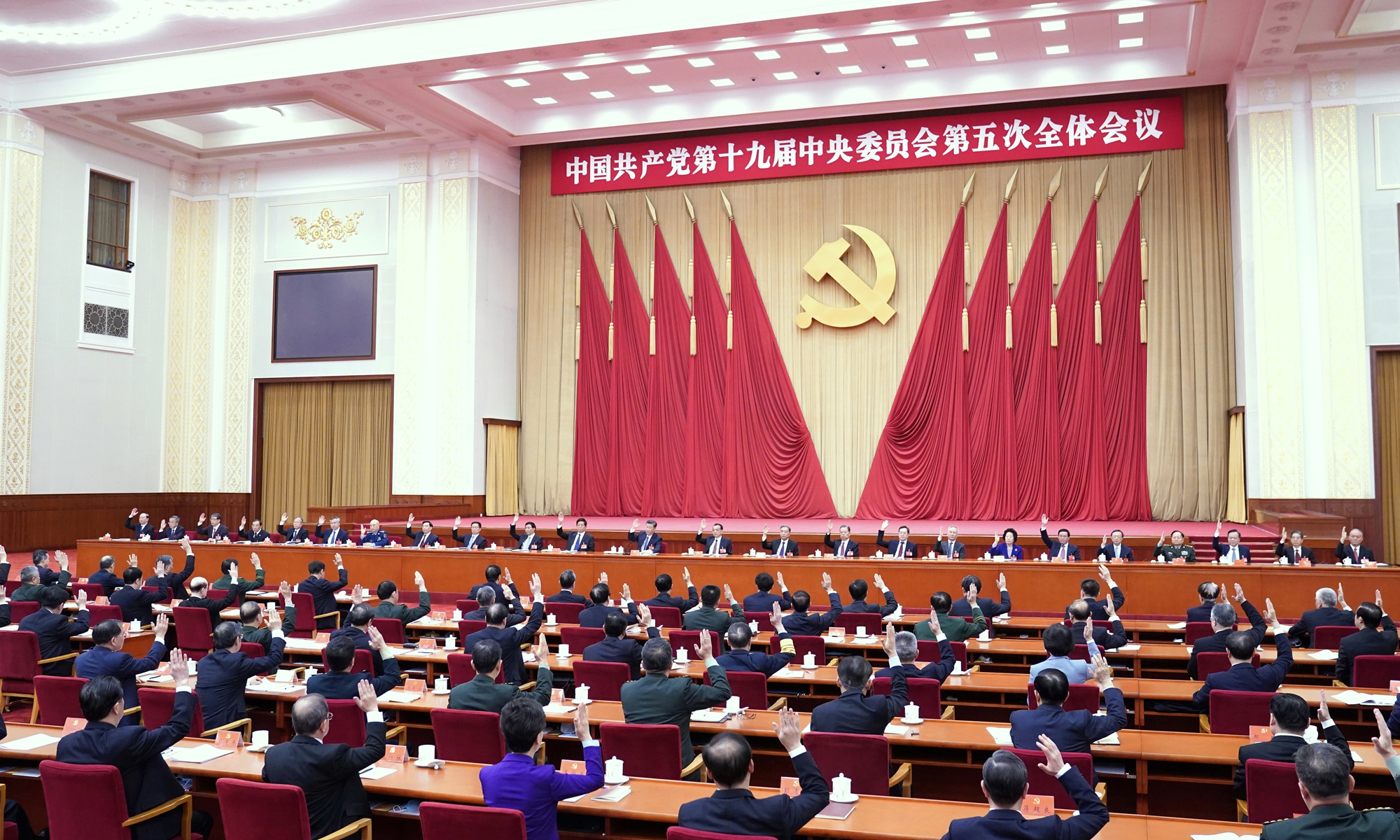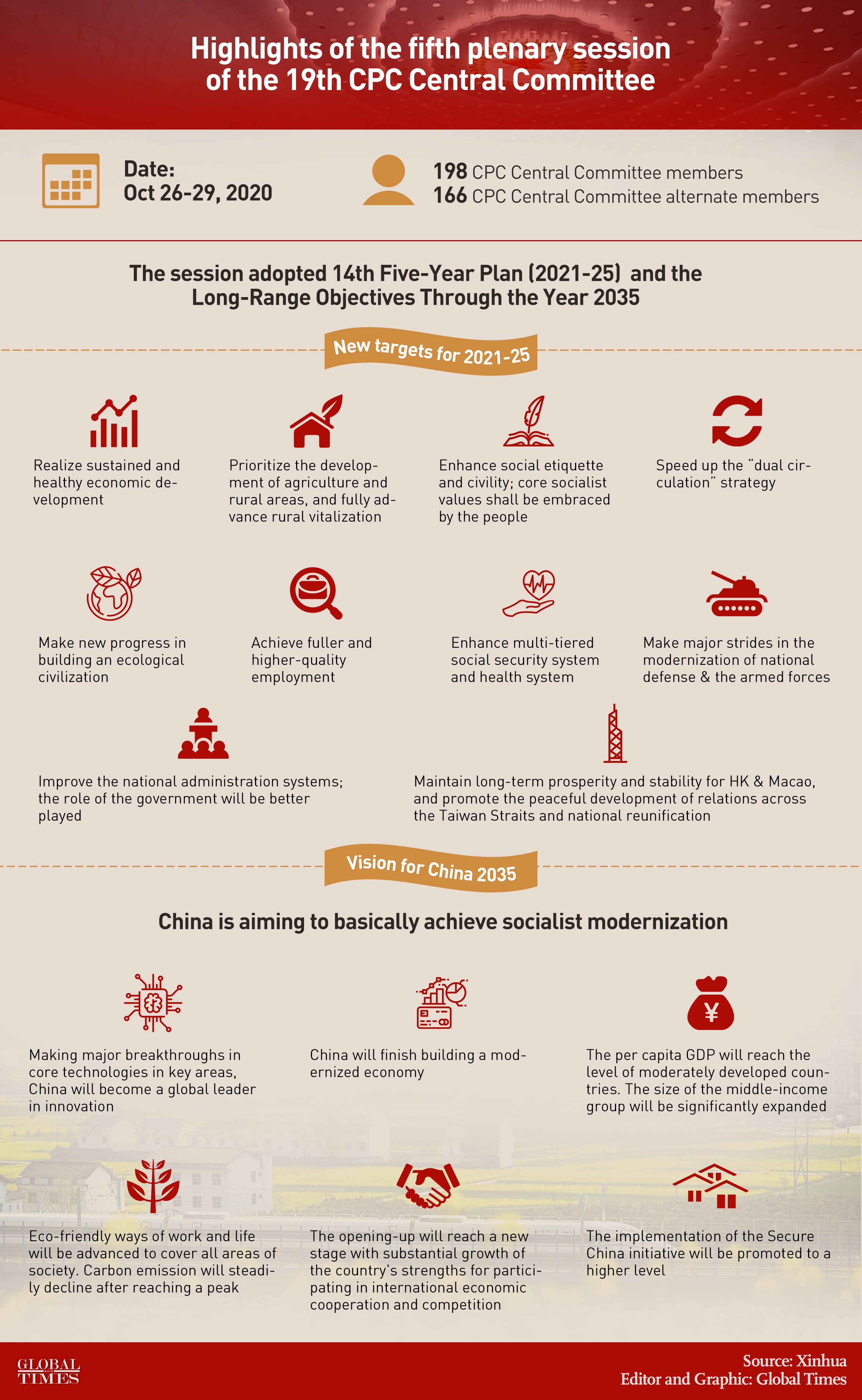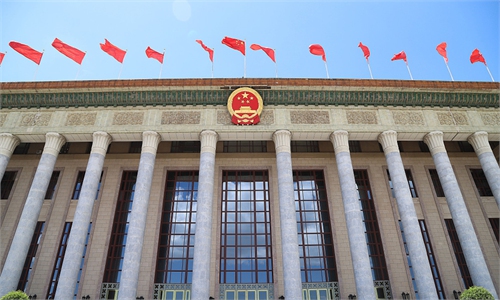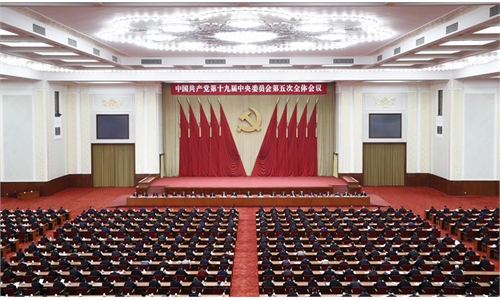China sets ‘pragmatic’ targets through 2035
Nation aims for ‘big leaps’ in economy, technology

The Fifth Plenum of the 19th Central Committee of the Communist Party of China concludes on Thursday. A communique was passed at the session which was held from Monday to Thursday. The session also adopted the CPC Central Committee's proposals for the formulation of the 14th Five-Year Plan (2021-2025) for National Economic and Social Development and the Long-Range Objectives Through the Year 2035. Photo: Xinhua
With decisive progress in the past five years and a strategic victory against the COVID-19, top leadership of the Communist Part of China (CPC) on Thursday unveiled a steady and bright picture for the country's future, as it sets sweeping social and economic development goals for the next five to 15 years that aim to build the world's most populous nation into a modern socialist power in the economic, technological and other fields by 2035.
In a wide-ranging communiqué released after the fifth plenary session of the 19th Central Committee of the CPC ended in Beijing, top officials conclude that China remains in a major strategic development period, citing "decisive achievements" in the past five years and "major strategic results" of the COVID-19 epidemic, and offered sweeping solutions in a wide range of areas, from economy, to security, and to governance.
While the communiqué projected confidence in China's development paths and prospects, certain targets, particularly in economic areas, reflected a cautious and pragmatic sentiment among top officials, given mounting domestic and external pressure on growth, while other goals such as greenhouse gas reductions underscored the country's determination to pursue high-quality growth and tackle global issues, experts said.
Sweeping targets
"Having deeply analyzed the profound and complex changes our country faces in its development, the plenary session believes that China's development remains in an important strategic period," the communiqué said, calling for strategic patience in overcoming challenges and striving for progress.
Among the key takeaways from the communiqué are sweeping targets sets for the 14th Five-Year Plan (2021-25) and long-range goals through the year 2035. Coming at a critical inflection point for China, the four-day meeting and the targets for the coming five to 15 years are essential steps in China's long-term goal for national rejuvenation. The 14th Five-Year Plan would also mark the start of the pursuit of the second centenary goal to build a modern socialist country.
"Previously, we usually set five-year plans, but this time we mentioned the 'long-range goals for 2035' for the first time. The time span extended from five years to 15 years. That shows we have become more strategic," Yang Xuedong, a professor of political science at Tsinghua University, told the Global Times on Thursday.
Under the goals in the communiqué, China will achieve modern socialism by 2035. What that entails includes achieving "big leaps" in economic strength, technological prowess as well as overall national strength, the document said. Total economic output and urban and rural income will reach a "new level," and major breakthroughs would be made in core technologies.
"I think those targets are very pragmatic as they reflect our advantages and long-term development goals, as well as the many challenges we have to face," Tian Yun, vice director of the Beijing Economic Operation Association, told the Global Times on Thursday.
Though the document refrained from offering specific empirical targets, Tian said that those goals could mean that China would double its current GDP of around 100 trillion yuan in 2035, and double current per capita GDP of $10,000. "That would require a real GDP growth of around 3.5 percent annually; it is a big target but can be done if China's full potential is realized," he said.
In keeping with a decades-long tradition, the communiqué also included goals for the 14th Five-Year Plan. During the coming five-year period, China will aim for "new achievements" and "sustained and sound growth" based on improvements in quality. The domestic market will be further boosted and economic structure would be improved, it said.
In a breakaway from previous five-year plans, the 14th Five-Year Plan did not include an annual growth target. In the 13th Five-Year Plan, an annual growth target of around 6.5 percent, which, experts say, could be missed due to the COVID-19 epidemic.
That decision reflected the considerable risks and challenges the country is confronted with, including the COVID-19 pandemic, experts noted.
The new five-year plan came at a critical juncture for the Chinese economy. Though China has effectively reined in the epidemic and embarked on a steady economic recovery path with a 4.9 percent growth in the third quarter in the year, the deadly virus continues to ravage across the world, which is already mired in rising trade and geopolitical tensions.
While the 6,200-word communiqué focused mostly on economic issues, it also touched on a long list of issues, including governance system, security, social fairness, education, healthcare, and environmental protection - all part of China's long-term strategy to build a modern socialist society.
In security, the communiqué called for modernizing its military. On environmental protection, the communiqué said that China will continue to reduce carbon dioxide emissions after reaching a peak by 2035, which experts called a "bold" pledge that reflects China's determination to tackle climate and environment issues.

Highlights of the fifth plenary session of the 19th CPC Central Committee Infographic: GT
Paths to success
The communiqué also outlined strategies and paths that China would take to overcome those challenges, and reach its goals in the medium-to-long term.
Among the major steps listed in the document is a strategy that has already gained widespread attention - the "dual circulation" model. In line with previous speeches from top officials, the communiqué called for forming a "powerful" domestic market and establishing a new growth model, where the internal circulation would play a main role in driving growth, though the external circulation would also be boosted. "Consumption would be boosted and room for investments would be expanded fully," the document said.
Though China is at a transitory period where both opportunities and challenges are abundant, "fully grasping the 'dual circulation' would turn this into a period of opportunities," Wang Huiyao, an adviser to China's State Council and president of the think tank Center for China and Globalization, told the Global Times on Thursday.
With China's exports, which have already been declining in recent years, facing a tough situation due to the raging pandemic and tensions, Chinese policymakers are counting on the massive domestic market to ensure economic growth and security. China, which already has a middle-income population of over 400 million, is set to overtake the US as the world's biggest consumer market in the coming years.
Aside from the "dual circulation" strategy, the communiqué also highlighted the country's focus on technological innovation to drive sustainable growth, calling it an "innovation-driven" development strategy, and aiming to become a global leader in innovation. The Chinese character for innovation appeared nearly 20 times in the document, and for technology, 13 times.
"One of the most important points in the communiqué is mentioning innovation as a core national strategy… Facing the complex global situation, China needs to improve these areas," Wang said.
However, as the communiqué has made clear, focusing on the internal circulation does not mean China will turn inward and stop its long-standing opening-up policies. China will firmly adhere to its opening-up paths, and will continuously expand opening-up at a higher level, the document said.
"When we talk about the 14th Five-Year Plan, we shouldn't stress its effect on domestic development. It also has a significant meaning globally. China's economy is the engine for the global economy. China achieving a strategic victory against the epidemic and sustained economic growth is also a dose of confidence for the world," Yang said.






